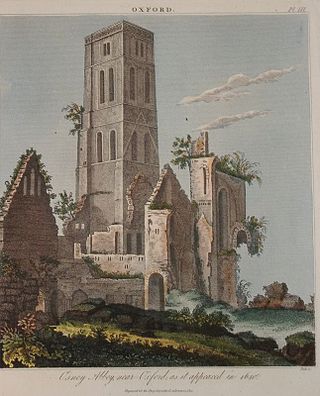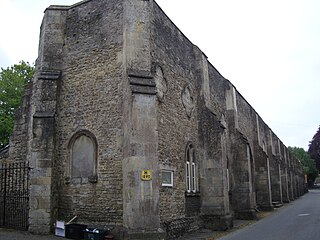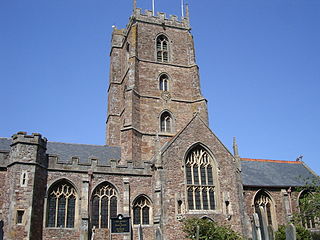
Abbey Hotel (also known as the Llanthony Priory Hotel) is a Grade I listed building incorporating a hotel and country inn in Llanthony, Monmouthshire, Wales.

Abbey Hotel (also known as the Llanthony Priory Hotel) is a Grade I listed building incorporating a hotel and country inn in Llanthony, Monmouthshire, Wales.
The Abbey Hotel is located next to the ruins of Llanthony Priory and actually incorporates the south-west tower of the monastic building. The remainder of the building may have originally been the lodgings for the prior. [1] The surrounding Augustinian priory originated around 1100, and the presently existing church, chapter house and cloisters were built between 1180 and 1220. After being dissolved in 1538, the priory fell into disrepair. [2] The building that is now the hotel was remodelled in the early 19th century, probably by the poet Walter Savage Landor, who bought the abbey in 1803 and lived on the site for a short period. [1] The four-storey south-west tower of the priory was a direct adaptation of the original 13th-century structure. [1]
The hotel was given Grade I listing status in 1956. [1]
The hotel comprises only five bedrooms, one of them being at the top of the tower and reached by 62 narrow steps. [3] In 2001 all five bedrooms shared one bathroom, located in the tower. [4] A pub and dining room is on the ground floor serving drinks and meals. [4] The bar is located in a vaulted 13th-century undercroft. [1] There is a large covered veranda for public use. [5]

Dore Abbey is a former Cistercian abbey in the village of Abbey Dore in the Golden Valley, Herefordshire, England. A large part of the original medieval building has been used since the 16th century as the parish church, with remaining parts either now ruined or no longer extant.

St Osyth is an English village and civil parish in the Tendring District of north-east Essex, about 5 miles (8.0 km) west of Clacton-on-Sea and 12 miles (19.3 km) south-east of Colchester. It lies on the B1027, Colchester–Clacton road. The village is named after Osgyth, a 7th-century saint and princess. Locally, the name is sometimes pronounced "Toosey". It is claimed to be the driest recorded place in the United Kingdom. In 2011 it had a population of 4,277.

Carlisle Cathedral, formally the Cathedral Church of the Holy and Undivided Trinity in Carlisle, is a Grade I listed Anglican cathedral in the city of Carlisle, Cumbria, England. It was founded as an Augustinian priory and became a cathedral in 1133. It is also the seat of the Bishop of Carlisle.

Aberconwy Abbey was a Cistercian foundation at Conwy, later transferred to Maenan near Llanrwst, and in the 13th century was the most important abbey in the north of Wales.

Llanthony Priory is a partly ruined former Augustinian priory in the secluded Vale of Ewyas, a steep-sided once-glaciated valley within the Black Mountains area of the Brecon Beacons National Park in Monmouthshire, south east Wales. It lies seven miles north of Abergavenny on an old road to Hay-on-Wye at Llanthony. The priory ruins lie to the west of the prominent Hatterrall Ridge, a limb of the Black mountains. The main ruins are under the care of Cadw and entrance is free.

Osney Abbey or Oseney Abbey, later Osney Cathedral, was a house of Augustinian canons at Osney in Oxfordshire. The site is south of the modern Botley Road, down Mill Street by Osney Cemetery, next to the railway line just south of Oxford station. It was founded as a priory in 1129, becoming an abbey around 1154. It was dissolved in 1539 but was created a cathedral, the last abbot Robert King becoming the first Bishop of Oxford. The see was transferred to the new foundation of Christ Church in 1545 and the building fell into ruin. It was one of the four renowned monastic houses of medieval Oxford, along with St Frideswide's Priory, Rewley and Godstow.

Bruton Abbey in Bruton, Somerset was founded as a house of Augustinian canons in about 1127, and became an abbey in 1511, shortly before its dissolution in 1539. It was endowed with manors, churches and other properties in the area and also in Normandy in France.

The Vale of Ewyas is the steep-sided and secluded valley of the River Honddu, in the Black Mountains of Wales and within the Brecon Beacons National Park. As well as its outstanding beauty, it is known for the ruins of Llanthony Priory, and for several noteworthy churches such as those at Capel-y-ffin and Cwmyoy. It is sometimes referred to as the "Llanthony Valley" as Llanthony is the village situated at the valley centre.

Llanthony Secunda Priory was a house of Augustinian canons in the parish of Hempsted, Gloucestershire, England, situated about 1/2 a mile south-west of Gloucester Castle in the City of Gloucester. It was founded in 1136 by Miles de Gloucester, 1st Earl of Hereford, a great magnate based in the west of England and the Welsh Marches, hereditary Constable of England and Sheriff of Gloucestershire, as a secondary house and refuge for the canons of Llanthony Priory in the Vale of Ewyas, within his Lordship of Brecknock in what is now Monmouthshire, Wales. The surviving remains of the Priory were designated as Grade I listed in 1952 and the wider site is a scheduled ancient monument. In 2013 the Llanthony Secunda Priory Trust received funds for restoration work which was completed in August 2018 when it re-opened to the public.

Llanthony is a village in the community of Crucorney on the northern edge of Monmouthshire, South East Wales, United Kingdom.

The Parish and Priory Church of St Mary is located in Chepstow, Monmouthshire, south east Wales. Parts of the building, including its ornate west doorway, date from the late 11th century and are contemporary with the nearby Norman castle. The church is a Grade I listed building.

Dunster Priory was established as a Benedictine monastery around 1100 in Dunster, Somerset, England.

Rumburgh Priory was a Benedictine priory located in the village of Rumburgh in the English county of Suffolk. The priory was founded in about 1065 as a cell of St Benet's Abbey at Hulme in Norfolk. At the time of the Domesday Book in 1086 it had 12 monks. The ownership of the priory was transferred to St Mary's Abbey in York towards the end of the 12th century. The monks of Rumburgh were particularly devoted to St. Bee, whom they commemorated at Michaelmas.

Monmouthshire is a county and principal area of Wales. It borders Torfaen and Newport to the west; Herefordshire and Gloucestershire to the east; and Powys to the north. The largest town is Abergavenny, with the other major towns being Chepstow, Monmouth, and Usk. The county is 850 km2 in extent, with a population of 95,200 as of 2020. The present county was formed under the Local Government (Wales) Act 1994, which came into effect in 1996, and comprises some sixty percent of the historic county. Between 1974 and 1996, the county was known by the ancient title of Gwent, recalling the medieval Welsh kingdom. In his essay on local government in the fifth and final volume of the Gwent County History, Robert McCloy suggests that the governance of "no county in the United Kingdom in the twentieth century was so transformed as that of Monmouthshire".

Crucorney Welsh: Crucornau is a community in the county of Monmouthshire, Wales. It is the northernmost community in the county and covers the villages of Llanvihangel Crucorney, Pandy, Cwmyoy and Llanthony amongst others. The Vale of Ewyas comprises much of the northern part of the community, with the River Honddu running through Llanthony and Llanvihangel Crucorney, before turning northeast passing Pandy towards the River Monnow. The 2011 population was 1,201.

St Mary's Church, also called St Mary Virgin Church, is a Church in Wales parish church in Caldicot, Monmouthshire, Wales. There is evidence that the church has pre-Norman foundations; however, the earliest part of the building dates from the 14th century. It is a Grade I listed building.
Penrhiw Priory was originally built as a vicarage in St Davids, Pembrokeshire, Wales, in 1884. The building was enlarged in the 1960s, serving for a time as a priory. In 2008 The Retreats Group Trust bought the building and commissioned Acanthus Holden Architects it undertake its conversion into a hotel. Then in 2012, Penrhiw Priory reopened as an eight-bedroom hotel restored along with Roch Castle and Twr y Felin Hotel, by the Griffiths Roch Foundation, which was set up in 2009 by international architect Keith Griffiths. It is a Grade-II listed building.

Llanthony Abbey is a former Anglican monastic institution founded in 1869 by Joseph Leycester Lyne, in the Welsh village of Capel-y-ffin, a few miles from the medieval Llanthony Priory. It survived until 1908, after which it was the home of artist Eric Gill. It is now holiday accommodation.

Hitchin Priory in Hitchin in Hertfordshire is today a hotel built in about 1700 on the site of a Carmelite friary founded in 1317, which was closed in the Dissolution of the Monasteries during the reign of Henry VIII. Parts of the original priory are incorporated in the existing building, which has been a Grade I listed building on the Register of Historic England since 1951.